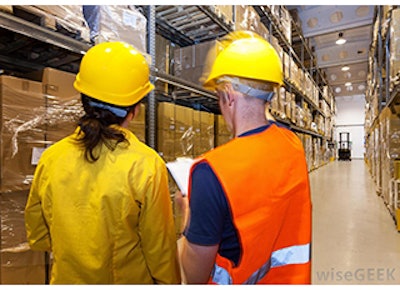
Purveyors of foods and beverages are gearing up for what is expected to be a robust holiday buying season in 2014. Market research firm eMarketer projects a 17 percent increase in overall e-commerce sales. The hiring of temporary seasonal workers is in full force to meet this demand — with UPS hiring some 95,000 workers, Amazon bringing in 80,000 warehouse workers, and FedEX taking on nearly 55,000 people, according to news reports.
During this peak season, safety is sometimes relegated to the back of the pallet in the haste to fulfill orders. But it’s more important than ever to have strategies and equipment in place to protect temporary workers who are less familiar with distribution centers and warehouses than people who spend all their livelihoods in such venues.
It behooves companies to consider ad hoc equipment needs to make their environments productive and safe, and to maintain industry best practices. Complacency to safety issues is a clear and present danger.
Keeping Workers out of Harm’s Way
Food and beverage distributors need to think about such things as safety fencing, railings, netting, pipe bollards, column protectors, mirrors, ergo mats, machine guarding and proximity alarms, to name a few.
It seems obvious, but it’s imperative that employees and forklifts are kept a safe distance from one another. Safety netting is important, especially when workers are directly under inventory. Guard rails keep picking areas and loading zones segregated. Mirrors provide at-a-glance awareness of surrounding traffic. End of aisle guards protect inventory.
The importance of these protective measures cannot be understated. Here’s one example in particular.
During other times of the year, there may be only one person in a zone, but in a peak season where an organization’s throughput reaches 50,000 cartons per day or more, the number of workers in that zone may quadruple. The key is making those workers aware of the dangers around them and taking measures to protect them.
Think about a worker’s location in relation to a conveyor or other piece of machinery. If the equipment is out of reach it is considered guarded by location. If not, that’s where guard rail, bottom covers, or other type of guarding can be installed for protection. Physical barriers are important to help people identify potential hazardous areas. They are relatively inexpensive pieces of equipment compared to lawsuits that can ensue. Not to mention the peace of mind that results from preventing one of your people from getting hurt.
If you’re that company facing a lawsuit and you can say that you have taken all the recommended precautions, then it goes a long way toward mitigating culpability. That’s where an experienced integrator can help optimize processes, increase accuracy and throughput – and be the sounding board for forgotten incidentals.
It’s not just people you want to keep secure; it’s about protecting your inventory, too. Temporary workers don’t have as much to lose as tenured employees. If you’re a wine retailer that handles expensive Bordeaux, you have to think about guarding and protecting your inventory against theft. Use lockable security cabinets or cages, for such valuables.
Enforcing Safety Practices
Part of the culture of safety is educating people about the rules. Give them every tool possible for safety.
Most temporary workers are not driving a fork lift. Companies are pretty serious about who is being trained on equipment. However, temporary workers are walking the same aisles as forklifts. They have to be educated and made aware of where to walk and they need to be trained to be able to take advantage of the safety equipment being deployed. Consider posting safety signs that remind workers of potential danger. Good common sense can sometimes be replaced with complacency. A well placed sign reminds workers to keep their eyes open and be aware of their surroundings as they move about the warehouse.
People can become immune to safety issues because they are in these areas every day. Proximity sensors or alarms are antidotes – and not just for vehicles backing up in the warehouse. Motion detectors trigger audible and visible alarms, and clearly marked aisles help people understand where they can and cannot be walking.
Tapping the Experts for Help
Don’t think that you have to solve all these issues on your own. Look to material handling experts, especially ones with engineering and design expertise, and not just ones selling products. It helps to be talking to sources with experience in tough storage, workflow and other material handling issues.
Even though the busy holiday buying season is but a few months of the year, expert sources can help you solve current issues that may also solve longer term problems, too.
Finally, here are some key questions to ask yourself and your organization:
- Are traffic patterns clearly marked?
- Does your warehouse have mirrors for better visibility?
- Are employees protected from forklift traffic with safety rails or other barriers?
- Are there any unprotected overhead loads where employees are working?
- How can you make it safer for those unfamiliar with your facility?
- Is your inventory protected?
By ensuring the safety of all workers this holiday season, and throughout the rest of the year, food and beverage distributors stand to meet their business and safety objectives. And that’s something worth toasting.
Don DeSimone is Director of Warehouse Equipment Sales at Wynright Corporation, a wholly owned subsidiary of Daifuku Webb and a leading U.S.-based provider of intelligent material handling systems. With more than 200 engineers in-house, Wynright designs, manufactures, integrates and installs a full spectrum of intralogistics solutions, offering both Wynright-branded and third-party equipment to meet client needs. He can be reached at [email protected].



















